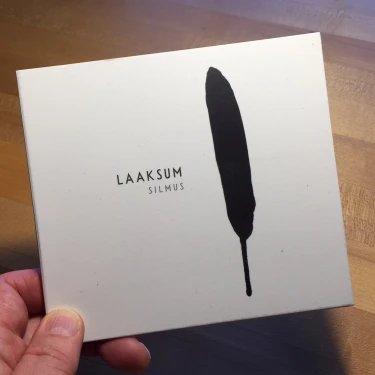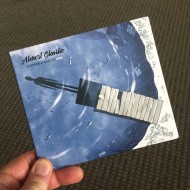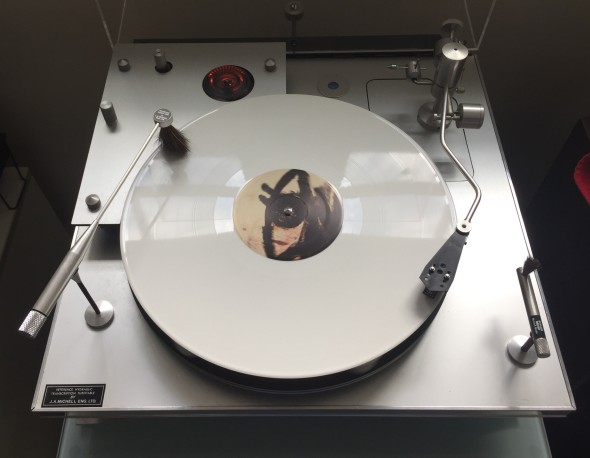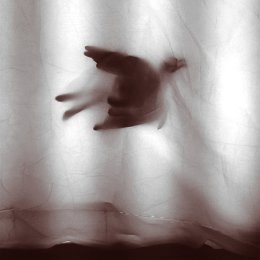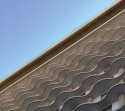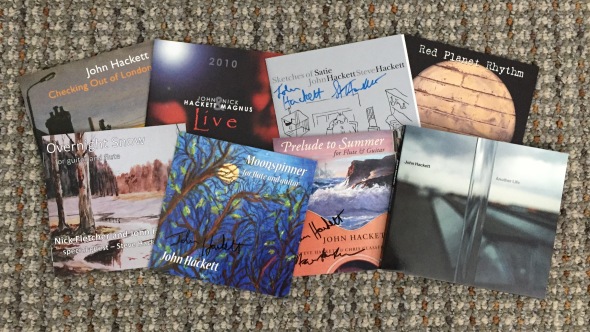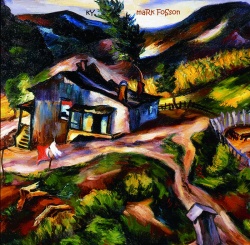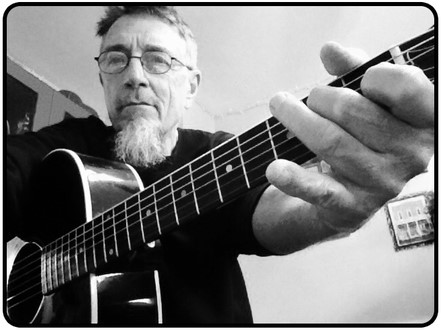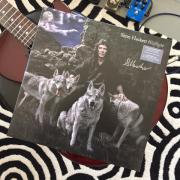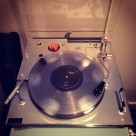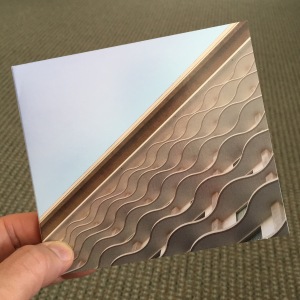Mariska Baars / Rutger Zuydervelt – eau
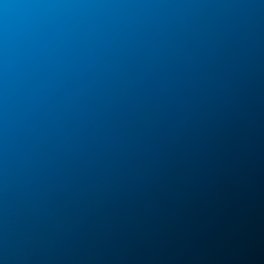
CD and Download Time: 30:10
https://machinefabriek.bandcamp.com/album/eau
There is an awakening, but the mind is foggy, vision blurry and hearing is trying to clarify. Then the realization, the nearly imperceptible, but ever-present rhythm of waves, and the enduring ebb and flow of the tides. It is caused by the slow dance of the Earth and Moon as well as the sinuous atmosphere. The flow is incoming, then retreating, at advancing times each day. The macro-rhythm of the water moves predictably, but it’s never the same. One could awaken one day to an ebb, and the next to a flood.
States of mind can change in daydreams as alpha waves are created and then dispersed by fleeting sounds, glimmers of light, gentle movements or drifting aromas. Where do we begin with eau, where do we end, does it really matter? Perhaps, in a way, that’s kind of the idea. It’s cyclical, it cleanses the mind, washing away thoughts that are distracting, while immersion within it aids in blurring the sense of time.
Although moderately indistinct while in a state of relaxation, I detect that eau is divided into four parts, but again, does it really matter to the overall perception of the experience?
One: At first, jittery granular voices, with gently plucked electric guitar (buzzing occasionally with a tightly controlled Frippian growl). Then there are more distinct and gradually entwined loops of voices and guitar, which transform into choral harmonies.
Two: About halfway into the recording there is a respite of tonal percussion, keyboards and (perhaps) guitar harmonics, but still with a gentle undercurrent of voices. It’s like lying in the bottom of a boat, in a gentle breeze, and hearing the water gently wash against the hull.
Three: At about seventeen-and-a-half minutes, voices and guitar return (recurrent flow), but it is a tide with percussive flotsam and jetsam. Some surprises have washed in. Sounds are crisper.
Four: Just before twenty-two minutes, a threshold is encountered after expanding layers of voices and sizzle (more of that subtle growl too). Then…a plucked string casts the sounds off into the distance, where they gradually become more indistinct. The voices and sounds are gradually hushed, akin to a quiet harbor at night. A fog seems to roll in, with the quietude.
In a way, like the shift of advancing tidal rhythms, eau could be encountered at any point in the recording, and left to loop, even slowing the speed to change the sounds and distort the sense of time further. The choice of how to encounter eau could be up to the listener.
There are no rip currents here, only calm seas.
****
Mariska Baars has worked with Rutger Zuydervelt both as a duo in 2008, on the album Drawn as well as with the quartet Piiptsjilling. Rutger Zuydervelt records as a solo artist, as well as with many different collaborators and is also known by the moniker Machinefabriek. EAU was mastered by sound artist and musician Stephan Mathieu.
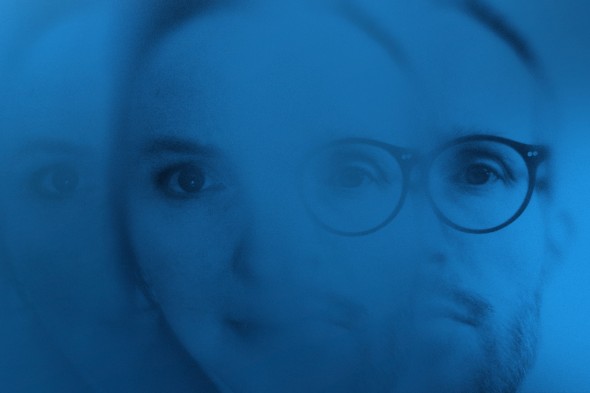
This is a solicited review.
Dolphin Midwives – Liminal Garden
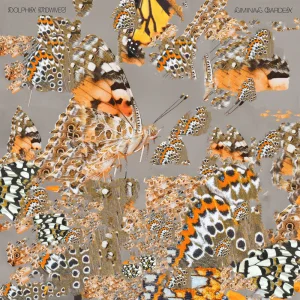
Available Formats: LP & Digital
Time: About 40 minutes
Labels: Sounds et al: ETAL011 & Beacon Sound: BNSD031
Tracks: 1) Grass Grow, 2) Junglespell, 3) Castleshell, 4) Flux, 5) Temple IV, 6) Mirror, 7) Labyrinth I, 8) Temple V, 9) Satya Yuga, 10) Iridesce
From an early age I have been fascinated by the sound and look of a harp. While some watched the Marx Brothers for the comedy, I was waiting for the ritual of Harpo’s performance—the calm respite from the chaos. Later, it was Bach Partitas played by Nicanor Zabaleta and other harpists and ensembles, and then improvisations and atmospheres played by Andreas Vollenweider (who was unfortunately pigeon-holed in the ghastly ‘New Age’ record bins in the 1980s). Thank goodness there’s a new generation continuing to make music with their harps.
No matter the genre, hearing music from a harp can be a riveting and even a mystical experience. A harp can supplement the atmosphere of a larger work of music or it can stimulate on its own, generating inner subconscious reactions (as instrumental music tends to do). It can be abstract or symbolic—cascading water, sun in the clouds, soft gentle repetitions to calm or to be invited into another realm beside the present.
Sage Fisher composes and performs with a harp, percussion, effects, and her voice. She is an experimental sound artist from Portland, Oregon, and Dolphin Midwives is the name of her performance project. As far as I can gather Liminal Garden is her second full length album (Orchid Milk appears to be her first in 2016—available on her Bandcamp page). I think that Liminal Garden has mystical or spiritual references that I am not qualified to interpret (some mysteries are better left unsolved), but I speculate that this album is a journey of exploration in two episodes, whether it is experienced as a two-sided LP or as a continuous thread in a digital music stream.
Each of the two parts starts with an abstract centering and cleansing vocal prologue (Grass Grow and Mirror), where short themes are established and then altered with looping effects, samples and down and up octaves—a loosely narrated trip that gradually arrives at an altered state, where a sense of time can be lost. It could even be the beginning of an escape from our current unstable world condition. The two interconnected meditations then have sharp contrasts throughout—think of slipping from the comfort of a hot pool of water into the shock of one that is frigid. There is a momentary shudder, but then the realization that the entire experience is about an awakening of all the senses to understand and embrace the whole.
Once fully absorbed, Junglespell is a transition from a peaceful start into a star gate sequence akin to Bowman’s journey of enlightenment near the end of 2001 A Space Odyssey. Here there is no vocal to guide, and there is a transformed sense of perception leaving subconscious thought to interpret. Not only is the sound entrancing, but watching it being created is equally as fascinating.
Once released from Junglespell, a slow awakening begins in Castleshell, arriving somewhere else, perhaps a bit dazed from a dream, out the other side of that star gate. The sharp contrast of Flux stimulates other parts of the mind that have been quietly idle. There is an electric energy of realignment, a jarring altered-state glitchy repetition. Then balance returns in the absorbing Temple IV with short tangible loops and a short melody that meanders within a tight range.
Part two of the journey is somewhat different and is introduced with Mirror. It has layered cascading vocals in varying octaves altered with electronic effects, octaves and loops. Rather than continuing on into a hypnotic state, another contrast is entered in Labyrinth I, which is disorienting with stimulus from all sides, seeking and not finding a way out. From the cold pool to the warm, the immersive and enveloping Temple V’s melodic percussion reminds me of Kraftwerk’s Klingklang (Kraftwerk 2 – 1972). Then there is a clear return of the harp with a gentleness and purity of the enlightening Satya Yuga, a respite of reflection and balance from the prior experiences. The epilogue to the album is Iridesce, a colorful stuttering of altered voices and electronics.
One cannot know the calm without experiencing the chaos. On what mesmerizing journey will Sage Fisher take us next?
The album was recorded by Jason Powers, and mastered by Rafael Anton Irisarri (Black Knoll), and the artwork is by Bijan Berahimi.
****
This is a solicited review.
Silmus – Laaksum
Volkoren 82 – CD Time: 43:53
1) Laaxum 2) Dancing On The Pier, Discovering The Sea 3) Hectanred 4) The Spirit of Morning Light 5) Raise Up 6) Meeting At Stonerow 7) Silence Is Black 8) Sacred Place 9) Wintering 10) Lay Myself Down
Gert Boersma (electric guitars, bow, khim, bass, melodica, harmonica, synthesizers, percussion, samples, effects and field recordings) is from the Netherlands, and is supported by musicians Jan Theodoor Borger (piano and effects), Minco Eggersman (drums, percussion), Guy Gelem (cello), and Mirjam Feenstra (vocals)
It’s been almost five years since we’ve heard from Gert Boersma of Silmus, but in the contemplative realm, seeking inspiration and summoning creativity can be an unpredictable long-term pursuit, and so, our patience is now rewarded.
There is a certain degree of speculation in reviews like these, but I feel relatively confident that Laaksum is inspired by evoking and honoring memories of a place, and I perceive that they are generally fond and formative recollections. The album is a sonic memoir of sorts, a solitary contemplation, and it delicately hovers between reverence and melancholy, but it is bereft of sentimentality.
Laaksum, the place, where I have never been, is on the shore of a remote inland bay in the province of Friesland, in north of the Netherlands, and is well-protected, apparently peaceful and a place where time might seemingly stand still. Memories are an inner form of time travel, and can return with seeing or holding an object, smelling a fragrance or hearing a sound—and any one can evoke all the others. I’m guessing, judging by the cover illustration that it starts with the appearance of a feather, and then what returns are the memories of the time spent at the jetty, the stand of trees, seeing flocks of seabirds, all of which are depicted in photographs and are the inspiration for the artwork within the tri-fold sleeve and booklet of the CD, envisioned with minimal embellishment by Daniel Thomassen.
Laaksum, the album, is mostly delicate, warm and peaceful. It’s impeccably recorded with a clarity and crispness of a clear noon sky in Spring—an auditory purity that is not overly precious. The instrumentation is widely varied, mostly acoustic, woody, but when it’s lush, it’s not self-indulgent. Boersma has taken great care in conveying his perception of that place from another time. It is a welcome and contemplative meditation in our current rather thoughtless and unsettled period in our collective history, an escape.
Laaxum, the track, seems to be symbolic of the catalyst where the memories return, but it is apparent that there are no storms here; mostly calm waters as those appearing in Dancing On The Pier, Discovering The Sea. The melodies in Hectanred are teased and appear as short tonal mantras—caught and then released, fleeting as a daydream lost in the ether. There are momentary diversions of perceived mystery or tension, as in Meeting At Stonerow or the ancient sounding Silence Is Black with occasional microtonal notes and dissonant chords, but overall the comfort and warmth prevail. The Spirit Of Morning Light has perhaps the most tangible clarity, as the rising sun reveals the sights and colors of the day.
As the seasons change, Wintering has both the layered vocal chill of the outside, but the comfort of a warm stringed suite on the inside. The epilogue, Lay Myself Down is perhaps an overall reflection, where the flood of the many years past is at first unclear and drifting, until a calm and clear melody gently presses through, where the memories from long ago become sorted and clarified, and where they can be forever held and retold.
****
This is a solicited review.
Karl Culley – Last

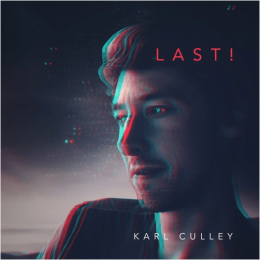
Format: Digital only
Time: About 74 minutes
Tracks: 1) Perfection Only Exists In The Mind 2) Nastassya 3) In A Sky Of Infinite Suns 4) Listen 5) Mistakes 6) The Föhn Wind 7) Wedding And Funeral Shoes 8) Amethyst 9) Devil In A Damn Fine Suit 10) Being Alive 11) 1, 2, 3 12) Delivered (My Maja) 13) Windows 14) Ghost Made Blood 15) Reality Is Like The Sun 16) How It Works 17) The Siege Of Antioch 18) Dale 19) St. Crispin’s Day 20) Embers 21) Looking Back Blues
Some readers may remember my review of Karl Culley’s 2015 album, Stripling. His new album Last (to be released on September 1, 2018) was recorded over the last three years in Culley’s home of Krakow, Poland. The good news is we have new music from Culley, and he is also now a father of a young daughter. The sad news is the turmoil in his life, a divorce, and due to various responsibilities he has decided this will be his “last” album of music.
The engineers for this album are Jaroslaw Zawadzki in Poland and Daniel Webster in England (the two tracks: Nastassya and Listen, with Webster playing all instruments, except for Culley on acoustic guitar). At first, I listened to this album at home, in my little studio, then I took it on a long road trip to and from the Adirondacks (in upper New York State), to get to know it better. It’s an excellent road trip album, by the way.
The subjects of this collection are both within the mind (things that can be imagined) and actual experiences (both joyous and painful). This album is pretty dense, and with 21 tracks, I found that I needed about two sittings to get through it, which is NOT at all a negative comment. Just the opposite, since the album is of a quality that demands a listener’s rapt attention. In my opinion, this is not a collection of background music. Coincidentally, at the mid-point of the album, is the metronomic instrumental 1, 2, 3, which serves as a bit of an intermission, before part two.
Culley deftly conveys the emotion of a given moment or the subject with only his acoustic guitar (ignoring the lyrics, for the moment), since the rhythms, strumming and picking reveal the intent of the song, like gently descending notes (like Embers falling in a fire) or a galloping heart beat (Being Alive) or the tender waltz (rocking cradle) beat and comfort and contentment in Delivered (My Maja). Maja also plays tricks with time, at first it’s the marvelous intimacy of having a newborn child on one’s chest, and then four lines later to “…unfurl to your consorts…” In a sense, preparing to release her to the world in her later years (children DO grow up quickly, as I can attest).
Without knowing (or wanting to know) the details of Culley’s private struggles over the last three years, it’s clear from this album that there are many complexities to love, relationships, and resentment. Have a listen to the darkness in Nastassya (which I am told is based on Dostoyevski’s The Idiot) or the anger and harsh reality in How It Works.
One of my clear favorites on this album is In A Sky Of Infinite Suns, with its snappy taut rhythm–I found that I kept hitting replay on my car CD player to keep the energy going. Another of the near-breathless pieces is Being Alive, with its galloping rhythm of angst “…just being alive hurt so much…looking into the mouth of a liar…like walking through the fire hurt so much…” (also sounding like a fast-beating heart with the lyric “…swells in the blood…”). By contrast there are contemplative meditations like Listen, and Reality Is Like The Sun that are both reflective and perhaps self-analytical (just like the more energetic and playful Mistakes). I wonder if KC finds that his own music can function as a form a therapy? I certainly find music to be quite therapeutic, whether energetic or comforting.
There are moments of keen observations of the bizarre, but absolutely true aspects of life, like in Wedding And Funeral Shoes, as well as moments of levity, Devil In A Damned Fine Suite. Overall, Last is a fine balance of musicianship and storytelling in a similar vein to the earlier acoustic works of Gordon Lightfoot, and if one listens carefully, one might pick-up the descending tones reminiscent of the opening to Nick Drake’s Chime Of The City Clock in The Siege Of Antioch (a pretty heavy observation on the First Crusade). The last song on the album, Looking Back Blues, is a reflection of sadness for a time past, but (perhaps) an appreciation that the passage of time can yield after the breakup of a relationship…there will always be a connection, especially when a child is involved.
I am sorry that Karl Culley is leaving the music scene, alas the realities and responsibilities of life somehow do take over, but I hope KC finds other rewarding endeavors for his talent and creative spark, and hope he enjoys watching his daughter grow up.
Take care and best wishes, Karl.
***
This is a solicited review.
Gone Quiet…
…in words, but not in music…
Please have a look and listen, and stay tuned.
Thanks for listening and reading.
A teaser…
Review: Almost Charlie – A Different Kind Of Here
Label: Words on Music WM43 CD Time: 36:55
Label: http://www.words-on-music.com/almostcharlie.html
Band: http://www.almostcharlie.com/
Tracks: 1) Shadow Boy 2) Ambivalent 3) The Sadness Of The Snow That Falls In May 4) Defective 5) The Loneliness Of Sharks 6) Waiting 7) Robot 8) A Different Kind Of Here 9) Sunset In The Elysian Fields 10) Expect For Her Name 11) Gold 12) I’ll Still Be Missing You
At last, the songs of Dirk Homuth and lyricist Charlie Mason return, in the latest Almost Charlie album A Different Kind Of Here. It seems that the older I get, the more I lose track of how quickly time passes—it’s already been about 4-1/2 years since their last album Tomorrow’s Yesterday.
It’s so easy to get drawn-in by the inventiveness and wit in their well-crafted songs, the melodies, hooks and restrained arrangements. All of the songs in this album can be quickly committed to memory, and there they remain, added to the playlist of the mind, but they are not simplistic. These songs are deftly efficient, and don’t overstay their welcome—each of the twelve is about 3 minutes long, with the last, longest and most sonically impressionistic, I’ll Still Be Missing You. There are connections between the moods of the music, arrangements and subjects. Listen in …Missing You for the wistful sounds of an implied telephone busy-signal layered back in the mix of the sound effects. In Waiting, the rhythm is like the finger-tapping of impatience. Yet there are contrasts, the upbeat tune of The Sadness Of The Snow… deals with the unexpected and unwelcome shivers of a late winter storm after experiencing the tease of Spring.
Homuth’s singing (with a voice reminiscent of John Lennon’s) varies from near-whispers in Defective to full-throated vocals with a spirited string quartet arrangement in Gold. What’s different from their previous albums: A lyrics booklet is included with this album (YAY!), and while the subjects of the songs is still largely about relationships, they are far more introspective, and some are darker and tend more towards melancholy. The Loneliness Of Sharks is initially stark, and gradually adds layers symbolic of the pressures of the deep and the isolation of power. There is also a short and reflective piano instrumental, Sunset On The Elysian Fields.

Overall, the recording of the album is remarkably spatial. Initially, I listened to the album sitting at a distance in a chair, in my car while driving, and then sat closer to the speakers in my music room, and felt like I was in the studio with the musicians while they were recording—so praise to the musicians in addition to those involved in the recording (Rob Cummings in Berlin is credited). The title track, A Different Kind Of Here, in particular is just plain gorgeous, the acoustic guitar, especially.
And imagine, the two songwriters still have never met (according to all that I have read). Despite the distance, the magic remains. Next time Charlie, please don’t wait so long before returning. This album, like their others, immediately gets put in the “hit replay” category. The Words On Music label (celebrating their 20th anniversary as an independent music label) sells it direct from their website for a great price, but it’s also available through your favorite music sellers. While you’re at it, buy the rest of Almost Charlie’s back catalog, you won’t be disappointed.
Here’s a three track sampler of the album:
****
This is a solicited review.
Braeyden Jae – Fog Mirror
 Label: Whited Sepulchre Records WS001
Label: Whited Sepulchre Records WS001
http://whitedsepulchrerecords.com/
https://whitedsepulchrerecords.bandcamp.com/
White Vinyl LP limited to 260, 30 premium include an ant’lrd split cassette with specialty insert. Time: About 42 minutes
Tracks: Vanishing Procession, More Washed Feeler, Obscured and Waiting, Two Mirrors Looking, Fogged Placer
With respect to music genres, where does ambient end and drone begin? Can music help to offer a refuge, focus the mind or distract it? Fog Mirror flirts with all of these possibilities. I admit to being puzzled at times on why some music needs to be so heavily shrouded with the melodic aspects pushed nearly out of reach, yet unexpected benefits can occur, like vanquishing a worrying thought, eroding it with sound. Admittedly, I don’t always understand the approach, but I appreciate the intent, especially if the quality of the recording is full and not bleached-out into an unpleasant monophonic haze.
Remember the moment in the original Star Trek pilot episode The Cage when Captain Pike and Mr. Spock touched a plant on the forbidden planet Talos IV? The layers of sounds emanating from the alien plants and the remaining ambient atmosphere were revealed…Spock even smiled. Never seen it? Here’s a reminder…
The point is, there is often an overall gestalt to sounds, music and atmospheres, being greater than the sum of their parts, and there is mystery and intrigue in imagining how those sounds were created if those parts were to be disassembled. The layering creates unexpected harmonies and overtones, and even unrelated memories of events can be activated.
Braeyden Jae’s latest album Fog Mirror (Braden McKenna’s nom de plume) clears the mind yet it can steer its focus in rather curious ways. Each piece has a perceptible aggregate tone (whether major or minor, deliberate or unintentional), and some tracks stay relatively stable, almost devoid of a perceptible melody, whereas others meander and ruggedly thrash beneath the haze. McKenna carefully disguises the sources of his sound generation, which I’m guessing are varying degrees of fuzz applied to an electric bass, piano (literal in Obscured and Waiting, but veiled elsewhere), along with various effects, treatments, noise and perhaps some field recordings. The illusion of water and wind, which appear to be created synthetically, are prominent throughout, offering the effect of cleansing, even if it suddenly appears as a deluge. Another quality of the recordings is the “Did I just hear that…?” aspect of the layering, like walking in the dark and seeing something move nearby or the flash of something moving beneath the surface of a body of water.
Vanishing Procession is like sitting behind a gentle waterfall with occasional peeks through the cascading water to a scene beyond, or sitting on an open porch with rain falling as time passes slowly by. There are some similarities the works of Nicholas Szczepanik, but McKenna’s variations in the layering of the sounds are more subtle. In contrast, More Washed Feeler is practically a deluge with a undercurrent of recirculating ascending and descending notes, a sonic mantra of sorts. Seven minutes into the piece, the torrent is forced open slightly to reveal a swirling undertow.
A steelier resonance is present in Obscured and Waiting, with a slow pulsing piano. This is the most identifiable, melodic and peaceful track on the album with a wooly-fuzz bass occasionally piercing the quietude off in the distance, sounding like shortwave radio sawtooth-wave interference. The piano evolves into sounding like far-off carillon bells. This is a rough-edged version of portions of Budd and Eno’s The Plateaux of Mirror.
There’s a veiled rhythmic gait working against a counterpoint of concealed peeling bells in Two Mirrors Looking. It’s more industrial-sounding with an undercurrent of an old shipyard recorded just below the surface of the water with a sudden harmonic shift at about 6-1/2 minutes as perhaps a ship’s screw passes by on its journey out to sea. The last and longest track on the album, Fogged Placer, I actually perceived as being the shortest—a rather odd time-shifting experience. This track allowed a memory of mine to return, back to the days when I commuted periodically to the Adirondack region of New York as a passenger in a twin-engine Piper aircraft—sitting in the back listening to the two engines shift the timing of their revolutions slightly, generating hypnotic vibrations and harmonics that were transmitted into the plane’s fuselage. At certain moments, it also sounds like watching a blanketed symphony performance, with my ears isolating the cellos and double-basses.
Finding a semblance of peace in absolute silence these days can be rather difficult (especially when unwanted tinnitus randomly appears), and an album like this can help achieve a frame of mind that allows an imaginary escape to evocative places and memories.
****
An aside, I wonder if Braden McKenna has ever heard the opening side of the 3 LP set of Consequences, by Kevin Godley and Lol Creme, produced in 1977? I could hear some similar background atmospheres, although the resulting piece is quite different.
On Sabbatical, Except…
As perhaps some of you have noticed, I’ve been on a bit of a sabbatical from regular reviews. I haven’t stopped doing reviews at all, but I have less to say for the moment. Instead I’ve been focusing more on my day job (designing buildings) and making some noise of my own (which better informs music reviews).
Please do continue to submit requests for reviews, but keep in mind that I might be more selective with what I choose to review.
Please also have a listen at the following link, I offer any of this music to young filmmakers, free of charge, and only ask in return for credit if you download and use any of this original material: https://wajobu.com/sounds/
Thank you for continuing to read and listen.
M. Ostermeier – Tiny Birds
Time: 34:28
Website: http://homenormal.com/
1) glide 2) of a feather 3) rafters 4) watcher 5) duo 6) flutter 7) flying south 8) head cut off 9) nesting 10) caged 11) skitter 12) twin crested peaks 13) albatross
M. Ostermeier: piano and sounds
Christoph Berg: violin on glide and of a feather
Photography: James Luckett – consumptive.org
In my part of the world, some birds that used to winter elsewhere now seem to stay here, but many still migrate: from swallows by the millions (spectacular departure throughout October) to songbirds like warblers to the more solitary bald eagles that pass through here on their way to nesting areas along local rivers and up to the Adirondack mountains in upper New York State. Just before the first break of Spring, woodpeckers return or emerge and the local forests can sound like giant marimbas as the oversized pileated variety pronounce their territorial claims, rapping on hollow trunks.
M. Ostermeier’s latest album is the avian themed Tiny Birds. There is a slightly different approach to Tiny Birds compared with his prior album still on Ostermeier’s Tench imprint. The piano instrumentals on still tend to meander somewhat with more liberated abstract forms whereas Tiny Birds is a more controlled series of repetitive melodic vignettes with variations—perceptive yet humble etudes with minimal embellishment or peregrinations—some more dulcet than others.
Despite their apparent simplicity there is still a great deal of subtle texture and depth in the recordings, and notwithstanding initial minimalist appearances, Ostermeier is quite adept at layering and revealing micro-sounds into his recordings, as in his earlier album The Rules of Another Small World. Soundscapes can be taken in as a larger whole while in a place or one can focus on the intimate.
The overall mood in Tiny Birds is mostly comfort with varying passages ranging from delicate to vibrant, but never jarring. The point of view is that of a bystander in quiet contemplation observing the moments, and as a result the music evokes visual memories. I try to resist comparisons to the works of others, but this one locked in my head and I couldn’t shake it: there are connections with some of Satie’s works and the pace (without vocals) is reminiscent of Brian Eno’s two meditations: Julie With and By This River from his 1977 album Before and After Science.
Aside from Ostermeier’s piano and delicate melodic and percussive treatments, Christoph Berg enhances the first two tracks, glide and of a feather with deftly restrained violin accompaniments. It also sounds like there might be some cello in the somewhat mournful flying south, adding weight to the depth of the long cyclical journey. A piano is generally the foundation throughout, and in glide the violin moves in and out of earshot like a golden eagle riding thermals high-up in the sky on the edge of human sight. Of a feather has slight chordal shifts and Berg responds to the piano phrases with a gentle sway.
 In summer days of my youth, some of my family used to help a farmer hay his fields and then methodically transfer hay bales from carts into an old barn loft while barn swallows were on the wing above in the rafters—this reminded me of those days, many years ago. Alighted and above, in the breezes, is the watcher, with languid wind chimes below, in a subtle duet. And as if in mid-conversation, duo picks up a somewhat less structured dialog between two birds in trees (is it an actual transcription?), like sometimes at dawn when windows are open and two great horned owls are conversing from opposite ends of the yard, or two robins singing their evening-song at dusk. Some visceral low frequencies pass through this too.
In summer days of my youth, some of my family used to help a farmer hay his fields and then methodically transfer hay bales from carts into an old barn loft while barn swallows were on the wing above in the rafters—this reminded me of those days, many years ago. Alighted and above, in the breezes, is the watcher, with languid wind chimes below, in a subtle duet. And as if in mid-conversation, duo picks up a somewhat less structured dialog between two birds in trees (is it an actual transcription?), like sometimes at dawn when windows are open and two great horned owls are conversing from opposite ends of the yard, or two robins singing their evening-song at dusk. Some visceral low frequencies pass through this too.
The most musical piece on the album, flutter, is at first a duet, then a trio, perhaps even a quartet, with brisk playful variations on the original melody. head cut off is a slow meandering stagger of sobering paired tones (no birds were harmed in the recording of this…I assume!). Gentle rustling with more intimate microphone placement at the piano, nesting has a slightly voyeuristic quality of a webcam keeping an eye on birds and chicks in a tree, safe from dangers below while swaying quietly in the breezes. The monotony of confinement is depicted in caged, where there are few changes with the passage of time. Skitter has five, perhaps even six sections with both an untreated and a slightly phased piano, punctuated by pure tones in between the melodic phrases. Twin crested peaks is a hypnotic call and response, with the regularity of an EKG taken at rest.
albatross can have several meanings, a golf term (AKA double-eagle, a rare three under par—a bird reference!), a psychological burden or the majestic sea bird with an enormous wing span (up to an incredible 12 feet) and they are often long-lived. There is a tagged female Laysan albatross named Wisdom that has returned to Midway Island for at least 63 years, and this year she mated and had another chick (estimated to be her 36th)– truly remarkable. This closing track is graceful of flight and steady, yet it carries the enduring burden and insight gathered with the passage of time.
My favorite tracks on the album are: glide, of a feather, flying south and albatross.
****
This is a solicited review.
Salvatore Passaro – Overwhelming
Label: mopstudio CD-R (Gatefold case with artwork by Mahnaz Esmaeili): MST 001 Time: 51:59
CD available at: http://www.mopstudio.com/site/
Digital files available at: https://salvatorepassaro.bandcamp.com/releases and at iTunes
Tracks: 1) Stone 2) Touch 3) A Light 4) Dream 5) Memory 6) Next 7) Circular 8)Blue 9) Overwhelming 10) Early Morning 11) Settembre 12) It Is 13) Trip 14) Sinestesia
There’s a somewhat enigmatic quality to this album: the instrumentation, what might have inspired the work and to a certain extent, Mr. Passaro himself. What I do know is Italy-based Passaro’s last work, a collaboration with Carlo Cossu entitled Earth, was released approximately 15 years ago, and there are some excerpts from that collaboration scattered around the internet (which I chose not to sample). Since I’m a bit of an equipment geek, I normally find background helpful, although I’m told by some musicians, “…never reveal your secrets…” Despite the album’s title, Overwhelming is a relatively calm offering that exists within a fairly narrow emotional range, with minimal sonic distractions and melodic directions. Whether spontaneous or scripted there are moments where Overwhelming leans toward the ambient music genre with an occasional sense of place, and others where it’s nearly sleep-inducing devoid of an identifiable physical realm, yet the music generally hovers somewhere in between.
 The instrumentation (real and/or virtual?) appears to be primarily electric guitar, piano and some electronic keyboards with various effects and treatments. The strongest sonic nudge is the opening track, Stone with purer sounds that are woven and sustained. Only near the end more forceful tones and grit enter the soundscape. Touch is more spacious with grainier qualities. Then the album settles into a more pleasant, swaying and peaceful interlude with A Light, Dream, Memory and Next. In this section places and memories are evoked with veiled sounds of a shoreline, wind, voices and the outdoors. Next is the most restful.
The instrumentation (real and/or virtual?) appears to be primarily electric guitar, piano and some electronic keyboards with various effects and treatments. The strongest sonic nudge is the opening track, Stone with purer sounds that are woven and sustained. Only near the end more forceful tones and grit enter the soundscape. Touch is more spacious with grainier qualities. Then the album settles into a more pleasant, swaying and peaceful interlude with A Light, Dream, Memory and Next. In this section places and memories are evoked with veiled sounds of a shoreline, wind, voices and the outdoors. Next is the most restful.
Many of the pieces seem to be improvised with minimal underlying structure (I could be entirely wrong). Circular has drifting voices co-mingling with piano and keyboards. Blue continues with even more random bell-like notes (perhaps on a heavily processed piano) until there appears to be momentary references to Vangelis’ Memories of Green. Ironically, the title track Overwhelming is one of the more sedate pieces on the album with gently rolling voices mixed with guitar and keyboards. Whereas, relatively true to its title, Early Morning has sounds emerging and blending much like the rising Sun as colors of a new day are gradually revealed as darkness wanes. Settembre is plucky, gritty and random. Phased, flanged and wandering is It Is, and Trip gently winds-up and then coasts with scenery wisping by in slow-motion. Sinestesia closes the album and is the haziest, layered and trance-inducing track, and it doesn’t stray far from its central sonic focus.
The CD version of the album is available directly from the artist at the website noted above with digital versions available at Bandcamp and iTunes.
****
This is a solicited review.
Western Skies Motel – Buried and Resurfaced
Twice Removed TR051 CD-R Time: 29:21
Label: https://twicerememberedtwiceremoved.bandcamp.com/
Artist: https://westernskiesmotel.bandcamp.com/
https://www.facebook.com/Western-Skies-Motel-310816295732546/
Tracks: 1) Awakening 2) Black Sea 3) The Quiet Rust 4) Passage 5) Echoes 6) Behind These Walls 7) Thaw 8) Distances
Buried and Resurfaced is the final release, of 60 albums and EPs, from the Twice Removed record label. Label curator Gavin Catling, in far away (from me) Perth (western) Australia, has done a fine job of bringing artists and musicians to our attention since 2011, and I’m sorry to see him put the label to bed, but understand his desire and need to bring the project to an end.
This album arrived here at an interesting moment; I had recently done some reading on the gradual and tragic decline of the Aral Sea between Kazakhstan and Uzbekistan. Some of what I have read and imagined about the decline of that landscape seems to have parallels in René Gonzalez Schelbeck’s musical creation, even the title. I have also just seen Guy Maddin’s adventurous, liquid-time-bending and bizarre film, The Forbidden Room, and in many ways Buried and Resurfaced could have been a soundtrack for that film. The film is an homage to old lost and often quirky movies, which Maddin reimagined, and they are collected as an amorphous omnibus that is almost beyond description and, at times, comprehension.
Another parallel to Buried is it can be beheld as either individual pieces or part of a larger whole with a real or imagined narrative. The tape-decayed and modulated passages in Buried blend remarkably well with Maddin’s visuals (firmly planted in my memory—it’s an intense film). The possible album storylines I have posited are two possible accounts, but there are many others, despite what might be the actual intent (if any) of RG Schelbeck.
There is an ancient and mysterious quality to the music from the start. Tape decay and flutter produces wrinkles in the perceived time continuum. The electric guitar is also well disguised with bowing, modulation, and effects, often yielding qualities akin to a long-neglected Mellotron or Chamberlin.
Awakening is the languid preparation for the journey and pending storm. Black Sea has a dark foundation and buffets with macabre winds lashing a hull at sea and occasional sonic breaching of the portholes (this piece is an especially perfect match for Maddin’s film). Quiet Rust is a peaceful yet unsettling aftermath to the storm with its sustained and reverberant atmosphere (this track is well mated with Schelbeck’s companion video: scenes of San Francisco after the devastating 1906 earthquake). It also reminds me a bit of Kane Ikin’s and David Wenngren’s collaboration Chalk from their 2012 album Strangers.
Being cast adrift in an increasingly dense fog is the texture of Passage with expanding and layered dark droning strings. Echoes pulses above and near before vibrating from the depths (a subwoofer helps to enhance this). Sounds move near, then are distant and fade into the ether. The most active and sweeping of the tracks is Behind These Walls, as if the storm of Black Sea returns, this time on land with squalls lashing relentlessly. I think I hear the warm and familiar hum of a tube amplifier in Thaw, with the percussive plucking of strings, as if water is dripping from ice in a warming sunshine. Buried and Resurfaced closes gently with the reflective and contemplative Distances with far off sounds of (perhaps field recordings of) nature absorbed into the haze.
My one criticism of the album (also a compliment), is the abbreviated timing of some of the pieces makes them seem rather elusive. Just when settling into the immersive aura of the music, some tracks fade away too soon, and I was left hoping that each would last longer for a more deeply enhanced experience. Perhaps extended versions might appear at some point in the future?
****
Trailer to Guy Maddin’s The Forbidden Room
****
This is a solicited review.
John Hackett – Another Life
Cherry Red Records – Esoteric Antenna EANTCD 1053 – CD Time: 48:59
Available at: http://shop.cherryred.co.uk/shopexd.asp?id=5158
More info at: http://johnhackett.com/ and https://www.facebook.com/hacktraxmusic?fref=ts
Tracks: 1) Another Life 2) Look Up 3) Poison Town 4) White Lines 5) Life In Reverse 6) Burnt Down Trees 7) Satellite 8) Forest 9) Magazine 10) Rain 11) Actors 12) Another Day, Another Night 13) Poison Town Reprise
It’s hard for me to believe that it was 10 years ago John Hackett released his last “electric” album Checking Out of London, a collaboration with lyricist Nick Clabburn, brother Steve Hackett, keyboardist Nick Magnus and guest vocalist Tony Patterson. COoL was largely an album of contemplation of modern realities with a fairly narrow and relatively calm emotional range (the song Ego & Id being the exception). Since COol John Hackett has released a collection of acoustic collaborations (see photo, I’m sure some are missing from my collection) and a live album with Nick Magnus in 2010, in addition to other session work with Magnus and others.
In contrast, Another Life exists in a darker realm, and is cathartic, but also treats the subject matter, at times, with sonic irony—where the music belies the lyrics, almost mocking the hopelessness or anger, reveling in the pain, getting to an even darker place perhaps in the hope to emerge in a better elsewhere. It’s not, however, necessarily a nihilist point of view. I also hesitate to say that Another Life is a concept album, but there is a tightly knit theme throughout.
The title track opens the album aggressively and builds to a primal scream of sorts. After listening to it a few times, I detected a structural pattern similar to the verse and refrain comparing it to In The Court of the Crimson King, including the point where John Hackett’s flute enters…coincidental or an homage? In Look Up “Everyone is changing…” and it is reminiscent of the sound of the change The Byrds sang of in the late 1960s (and distinctive opening chords like ELO’s 10538 Overture). The song is embedded with foreboding, but it has a driving energy of what I characterize as hope in the words “Look up and feel the light…” Poison Town is one of the examples of where the music seems to contradict the message of the lyrics, it has a sort of chill-vibe with the soft keyboards and wah-wah treatment of the guitar…kind of swaying and comforted in the darkness of thought. White Lines delves into frustration, with the Doppler-Effect sound and motion of vehicles speeding past on a highway, following the road into a vanished point in the distance…a destination never reached on an endless journey.
Life In Reverse on one hand is bleak, but there is a sense of optimism and beauty in the music—the chord shifts, layered chorus vocals and the gorgeous bridge from John Hackett’s flute (the passage “This rented room…This rented life…” with the chord bends and vocals is powerful). Another example of the sharp contrast of the message in the lyrics and music is Burnt Down Trees, as if one is mocking the other. The music is funky, rhythmic with ripping guitar solos from Steve Hackett, almost as if the music is laughing at reality while the streets burn; like the conditions are so bad, one needs comic relief or escapism. Ant Phillips is a guest instrumentalist on Satellite (12 string guitar and harpsichord). A song of conflicted feelings, opens with Steve Hackett on harmonica, with flowing chords and harmonies from the vocals and guitars. Stark truth and minimal sentimentality “Say how you feel…I just want to hear you try…” By the time Phillips’ rich sounding harpsichord enters, the difficulties of reality return—a very emotional piece, one that cannot be played loud enough to hear all the depth to the layers. Holding onto beauty in the face of despair.
Forest, in a way harkens back, in sound and instrumentation, to many of the songs on COoL. Reflection and self-examination, pondering how things could have gone, yet living with how they turned out. Magazine is the one piece on the album where Nick Magnus is credited as a songwriter along with Hackett and Clabburn. It’s another in the canon of gentle and contemplative songs, somewhat like the early instrumental piece by brother Steve Hammer In The Sand, although it passes through a couple of grander orchestral codas. Rain is perhaps a relationship gone bad (the actual inspiration could be completely different!) and in this the music and lyrics are aligned—the twisting sadness of the minor chords and the forceful vocal refrain, punctuated by Steve’s sustained growling solos.
There was something about Actors that sounded familiar to me…the lyrics seemed to have a parallel elsewhere, and sure enough, portions of the lyrics were used in the Squackett (Steve Hackett and Chris Squire) song Divided Self (a marvelous song, by the way—lyrics also by Clabburn). It’s a song of internal conflict—“Two tongues speaking in my head…” with a curious I Am The Walrus-esque link in the middle before the first guitar solo and vocal choruses. Another Day, Another Night has some sounds of hope with its upbeat rhythm and instrumentation, and is where the message is delivered to whatever is causing the feelings of darkness to move on—kind of an ultimatum with signs of optimism.
And then…the Poison Town Reprise…and a bit of the darkness returns.
Fear not the subject, just get lost in the music—I certainly have…as I click REPLAY.
Mark Fosson – kY
Big Otis Records – CD Time: 42:27
Tracks: 1) Jimmy Leg Mule 2) Loose Change 3) When We Were Young 4) Kingdom Come 5) Indian Summer 6) Dogwood 7) Simpleton 8) Cold Dark Hollow 9) Avondale Strut 10) A Drink w/ Stephen F. 11) Bad Part Of Town 12) Kentucky 13) Come Back John
Purchase CD here: https://markfosson.bandcamp.com/album/ky
Curious how things happen sometimes…
In the past few weeks I had been revisiting a number of acoustic guitar recordings from the United Artists era (early career) of Gordon Lightfoot, the vast acoustic 12 string guitar works of English composer Anthony Phillips (some recorded with Harry Williamson, like the open tunings of Gypsy Suite), Tompkins Square’s Imaginational Anthems series and even Mark Fosson’s Digging In The Dust. Then, I received a quite unexpected message from Fosson himself, asking if I’d be interested in reviewing his new album kY (named as an homage to his Kentucky roots and memories of his time there). His first album was recorded for John Fahey’s Takoma Records label in the late 1970s, but the label was sold before the album could be released (and it finally emerged courtesy of Drag City in 2006). Tompkins Square released Digging In The Dust in 2012, the 1976 demo recordings that ultimately led to the Takoma Sessions.
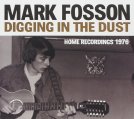
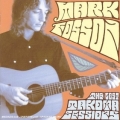
American Primitive Guitar, to some, is an obscure music genre (not to be confused with the American Primitivism art movement of the late 1890s). John Fahey’s pioneering acoustic guitar work in the 1950s developed an instrumental form of country blues finger-picking, and later attracted Leo Kottke, Peter Lang and others. In the 1960s and 1970s other techniques expanded the genre to include Robbie Basho, Mark Fosson, Jack Rose, and more recently Daniel Bachman, James Blackshaw and William Tyler (who works with both acoustic and electric guitars)…there are many others, and I am by no means an expert…just a general practitioner and admirer of many music genres and eras with some specialization in a few.
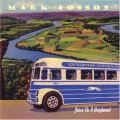
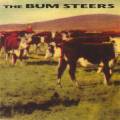
For background, Mark kindly provided a link to a recent interview at the excellent North Country Primitive website, which has some great insights on the album as well as what Fosson has been working on since those …Lost Takoma Sessions. For those interested in the specifics on the guitar tunings and instruments used on kY, I have linked directly to that interview here—it’s a great read. I have a hard enough time getting my slow fingers and feeble brain around the standard guitar tuning EADGBE let alone the many tunings like CFCFFC, so I marvel at the picking and musicianship within kY.
I am acquainted with some of Fosson’s other works spanning the time from 1976 to now, such as his solo work Jesus On A Greyhound as well as his band The Bum Steers. Fosson is also well known for the wit of his lyrics, but kY is an instrumental album, the music tells the stories, and the expressiveness and visual references emanating from the strings and fingers more than suffice in lieu of words.
kY is an album of clever and sensitive musical prose. Each piece being conceived and recorded almost spontaneously, most on first takes according to Fosson, to preserve the vibrancy of the moment. Laterally, this keeps the album unfettered of sentimentality, and refreshingly expressive even when the subject is poignant. A Drink With Stephen F, for example, went right to my core, and I felt like I had traveled through time and been a witness to the encounter—powerful stuff.
The pieces vary from portrayals of places, events and people. Four pieces are recorded with twelve-string guitar, two with banjo, one with dulcimer, two with guitars and bass (multi-track) and only two are in standard EADGBE tuning. I’m not sure what recording equipment Fosson used (analog or digital, microphones, etc.), but the quality and sound of the recording is so pure and crystalline—like a private concert in my living room. The final notes and harmonics on Come Back John just ring out, then sing on.
With the benefit of some insights from Mark Fosson (always helpful hearing it from the artist), an overview of kY, in the order of the recording:
Jimmy Leg Mule is a playful and somewhat unpredictable mule ride, with involuntary forays into mild dissonance due to that jimmy leg “condition”, along with moments of spirited progress, and occasional stubborn pauses–not unexpected from a mule. Loose Change is a somewhat gleefully reckless ensemble of guitar, bass, mandolin and slide guitar, which meanders from tight assemblage to rather “loose” chord interactions, and ultimately (and intentionally) to what author Henry Williamson referred to as a somewhat humorous “mingled despair” ending. Fosson recalls his grandparents in When We Were Young, a 12-string tribute, which varies from spirited interactions to moments of contemplation. The pace is that of a story being told, with occasional diversions (like pulling recollections from a distant hazy past), and resolved chords seem as welcome moments of reminiscing. Gradually, the themes fragment, and fade, like memories. When We Were Young periodically channels the sound of a venerable 19th century disc music box. Kingdom Come is a real place in eastern Kentucky (along with a State Park bearing the same name), and this banjo piece seems to capture the rugged yet reverent spirit of the place, although I have not been there…yet. As one might expect within a languid Indian Summer, Fosson’s 12 string jangles with a deliberate and steady heartbeat of keeping on, despite the heat.
I’ve always wanted to build a dulcimer, but for now listening to one will have to do, and Dogwood is a song of the country, and it could accompany a traditional dance or celebrate the arrival of spring, as those trees blossom. Simpleton has a cheerful and persistent aura with moments of pause for more intimate encounters. The second verse slips to a comparatively minor key, but the original balanced theme returns for the third. Fosson notes there was a man in his hometown with a sort of impairment who was a fixture. Fosson’s parents referred to this gent as the local “ambassador of good will”, others may have referred to him as something else less complimentary (we had one in my own town, we dubbed him: “the mayor”). It’s a jovial and charming portrayal.
Cold Dark Hollow is a slightly mysterious place where exploration is better fleeting with only brief moments of exploration, but not too closely, due to the chill. Fosson expressively flicks and buzzes his guitar. The second ensemble piece on the album is the 12-string guitar and bass Avondale Strut. It’s a lively gathering where folks have a good time after a spell of hard work. As I noted already, A Drink w/ Stephen F (in standard EADGBE tuning) stopped me in my tracks the first time I heard it, with its poignancy and clarity. The Stephen F is Stephen Foster, often referred to as the “father of American music” who died far too young and in a bad way (rough going back then, in the Bowery, where he died). It’s a respectful homage with an elegant and relatively unadorned melody. Some of Foster’s work has been forgotten to time and some remains well known (and is often labeled as “traditional”—do-daw, do-daw). This just exudes history and respect.
Bad Part Of Town swaggers furtively, yet it’s a cautious adventure as the banjo-ed observer passes through a neighborhood that is sometimes better avoided. Although Fosson isn’t entirely sure of the exact source of inspiration, Kentucky picks and snaps with a spirited liveliness. Closing the album is Come Back John, and is a fitting 12-string homage to mentor John Fahey. Fosson notes it was his desire to evoke Fahey’s Sunflower River Blues, and he does so with gracious aplomb.
I am often left unfulfilled by music that demands my attention. kY, however, is an album where an observant and clever artist deftly translates memories from mind to fretboard and fingers, creating authentic and fulfilling recollections. I’m not entirely sure this album qualifies exclusively as American Primitive Guitar (remember, I’m no expert), and there are no sixteen-minute free-range ramblers, but Mark Fosson instead has given us a collection of tidy and cohesive sound-memories, and they all work just fine, thank you.
Word has it that Mark Fosson has much more in the hopper, ready to record—excellent news!
Cory Allen – The Source
CD PR025 time: 40:53 (Also available as an LP, first 100 copies on coke clear vinyl)
1) Divine Waves – 12:11 2) White Wings – 8:53 3) Neon Mandalas – 6:58 4) Crown Canal – 12:48
Cory Allen: Hammond Organ, Harmonium, Tanpura, Rhodes Electric Piano, Violin, Voice, Mbira, Balalaika, Tibetan Singing Bowl, Gong, Tingsha Bells, Chinese Bells, Balinese Nut Shell Shaker
With Brent Fariss: Bass, Henna Chou: Cello and Lyman Hardy: Drums and Percussion
Artist: http://www.cory-allen.com/ Record label: http://www.punctumrecords.com/
Preorder link: http://www.punctumrecords.com/shop/coryallen-thesource
Without any prior guided experience to an astral realm of enlightenment, I feel a bit underqualified in commenting on certain aspects that may have influenced or inspired this album, but I feel perfectly at ease in speaking on the restorative nature of music, meditation and private contemplation. The mind is often so pre-occupied with distractions that thoughts become fragmented, confused, and the ability to concentrate is diminished—so at times a realignment is in order. Cory Allen’s new album, The Source provides a gentle yet intensive framework to cleanse the mind and re-focus awareness. In tech-speak: defragmenting the hard drive.
The Source, I think, is both a reflection of Allen’s own achievement of radial balance and self-unity, as well as a sonic guide for others to experience. With repeated auditions of the album, awareness of both the individual instrumentation and the gestalt of the overall effect of the work increases. For those less familiar with Cory Allen’s oeuvre, and before listening, an important aspect to keep in mind, is to suspend conventional expectations of musical structure and melody, and allow oneself to be drawn into the experience of both listening and feeling the sounds in the recording. Also, Allen’s work often uses a loosely rules-based construction including guided improvisation.
Divine Waves slow-dances on the edge of something resembling a liquid jazz with the initial two, three and four note phrases exchanging between cymbals and bass (plucked and later bowed). A tanpura joins the ensemble and its whirr is sustained by merging with the bass, cymbals, and chiming of inter-mingled bells and bowls. I hesitate to say that the cello is a later mournful addition to the group, yet it adds a wistful calm with an electric piano gently weaving throughout. The instrumentation in the latter part of Divine blends into a soft vibrating drone and is as much about the sound heard, as well as the interaction of the vibrations being felt (to experience this, I recommend listening with well-placed speakers at a volume roughly equivalent to match the original live sound of the instruments versus using headphones).
Initially focusing on the interplay of two and four notes phrases on a balalaika, White Wings’ bowed cello and bass, drums and harmonium absorb and weave while stretching varying dissonances. A first sonic alignment appears at a little more than two-and-a-half minutes, before meandering many times again with loose guidance (visually, like a flock of migrating swallows as they gather in the autumn, at sundown, seeking a resting place for the night).
The most intensive experience on the album is within Neon Mandalas; initially there is a chorus of deeply toned voices (which I think should have extended even longer), and once held in that realm, other elements are introduced with their fleeting movements (percussion, drums, bass and tanpura). A choir of gently plucked Mbiras (like a gentle steady rain) and bells provides a sonic background for an emergent and focused organ that dissolves into a returning familiar plucked acoustic bass phrase—a sort of arrival.
Crown Canal seems to represent a departure, reflecting on the fullness of the experience. The cello has a somewhat somber recurrent melody, reminiscent of a recessional or postlude, and has a tonality of resolution within a duo of a harmonium and tanpura. The ensemble is gently punctuated with percussion and voices. Despite being the longest piece on the album it has a curious absorptive quality, which compresses a sense of time, while achieving a state of steady entrancement.
The more I have listened to this album, it seems there is a general framework describing Allen’s own experience—the album appears to be a journey in four parts, describing what I interpret as: preparation, journey, arrival and return. The recording and mastering achieves a profound clarity and realism that I have come to know in Cory Allen’s previous albums, The Great Order and Pearls that feel as if the listener is within the environment where the music is being created.
The Source will be released on June 30th, 2015.
More on Cory Allen’s previous albums that I have reviewed can be found here.
The vinyl version of The Source–beautiful color!
****
This is a solicited review.
Damián Anache – Capturas del Único Camino
CD Time: 57:57, Digital, 300 copies of CD or 150 copies of Deluxe CD #CCL011 & #IR003
Tracks: 1) Paisaje Primero, 2) Paisaje Propio, 3) Paisaje Artificial, 4) Paisaje Natural
Websites: http://damiananache.com.ar/ &
https://damiananache.bandcamp.com/album/capturas-del-unico-camino
Labels: Concepto Cero & Inkilino Records
Think of the hour just before sunrise, in Spring especially, the Sun hasn’t yet peeked above the horizon. The songs of birds and sounds of other animals slowly rise with the Sun. Eventually there is a wondrous sonic aura filling the morning, until the Sun is firmly in the sky and the impromptu performance gradually fades. A similar effect occurs at sunset as the gentle evening-song of birds and other fauna greet the night. The sound landscape can, at certain locations, grow to be almost deafening, yet there still remains a feeling of ease and relaxation. Other sounds might enter: wind, rain, trees moving, a distant coyote howling to its pack or even the sounds of a city or shipyard. Taken as a whole, the soundscape has no apparent patterns or melodies, and it spontaneously exists without apparent forethought or design. Isolate individual elements with the ear and some patterns may be detectable, whether from a songbird or the rubbing of an insect’s wings.
Although Argentine composer Damián Anache’s method of creation for his debut album Capturas del Único Camino is different in its technical execution, the resulting experience is similar to how sound is generated in our environment. Anache’s works have been performed at events at the Conservatorio Santa Cecilia (Rome), National University of Cordoba (Argentina), Museum of Modern Art in Ecuador (Quito) and the Cultural Center of Spain in Buenos Aires, among others, in addition to his guest musician appearances at several performances of live experimental music, and as a producer of local rock bands in Argentina. This album is also an outgrowth of the research project Spatial Sound Synthesis in Electroacoustic Music, directed by Oscar Pablo Di Liscia at the National University of Quilmes.
In Capturas, Anache prepared a collection of recordings using acoustic instruments (piano, guitar, glockenspiel, percussion, etc.), voices (the composer’s voice, including falsetto), electronics and field recordings of water (distant and near-field). He then generated a series of four interconnected soundscapes using a software-based technique to randomly select and place the recorded sounds into an interlocked linear progression (I’m not familiar with the software, so I’m taking this at face-value). While the recordings are largely abstract, non-representational of place and without identifiable melodic or harmonic structure, they can be quite spatial in their interaction with each of the other recorded elements. There are also transitions between the four parts where fragments of the subsequent movement appear towards the end of the previous movement coupled with a mild crescendo to generate a disguising sleight-of-hand between the sections.
In Paisaje Primero, strings are plucked, hammered and bowed lightly, percussion is struck gently and the sounds are untreated and naturally resonant. This is the softest and most spacious of the four movements, more furtive than calming, and is without a detectable melody or pattern. Voices appear in Paisaje Primero within about two minutes of the transition to Paisaje Propio. There are also gentle whispers and hushed vocalizations combined with placid trills and hisses. At times, the voices have a character of bowed strings, and I could be wrong, but I also detect some sounds of what could be a cello.
Near the close of Paisaje Propio synthetic sounds are combined with the voices and the character of Paisaje Artificial shifts quite dramatically from the acoustic environment of the first two movements. Paisaje Artificial is more industrial with a static-electric atmosphere, where sounds could be generated by the interaction of conflicting frequencies of radio interference or magnetic waves as one moves through space. Some sounds are pure sine-wave, and the higher frequencies are crystalline and sometimes piercing; so the listeners’ ears should be somewhat prepared, especially if headphones are in use. On the cusp of passing from the Paisaje Artificial realm, the electronics seem to be mildly treated for the appearance of water in Paisaje Natural. Water is presented near and far, as drips, a stream, bubbles, waves and perhaps rain falling from a roof to the ground. There are short cycles in this piece that last about three or so minutes, like passing rain showers, so there is not only gentle motion in the individual recordings, but also in the overall movement. Near the mid-point of Paisaje Natural the sounds of birds appear in the distance, and the treatment of the recording shifts from one existing within the recordings to one of observing from a vantage point of some kind of shelter (this may be unintentional, and purely my own interpretation).
Capturas del Único Camino is well-suited to both a pure listening experience or as part of an audio-visual installation. Despite its apparent minimalist structure and execution, Damián Anache has created a curiously soothing yet complex realm in his debut recording. Rise early in the morn or linger at dimmity, and let the music be revealed.
****
This is a solicited review.
Drummassage
CD: 68bpm 001 Time: 41:26
Website: http://drummassage.com/ (Purchase option links at website will be “live” as of 4/28/15)
Tracks: Chimes (Intro), 68BPM, Interlude, Rolls, Heartbeat I, Chimes Coda, Heartbeat II
Performed by Phil Didlake, Leah Gramsjohnson, Isabella Iatarola, Tessa Kaslewicz, Ben Meyers, Clara Natonabah and Steve Wilkes, with support from the Berklee College of Music. Field recordings from the Hear Cape Cod project
****
Something a bit different from our standard music review…what is known as “functional music.”
Whether by means of self-hypnosis, meditation (such as TM) or other approaches, there is a point where the body and mind can achieve a surprising state of awareness in the midst of a deep calm. Along with others, Dr. Herbert Benson used the term The Relaxation Response to describe a multi-step process for achieving this state. One method to assist with relaxation is by using various forms of music. I can attest anecdotally to the healing and calming powers of certain forms of music.
The Drummassage album is an outgrowth of a project started by Steve Wilkes (a faculty member at the Berklee College of Music in Boston, Massachusetts). Some may recall that Steve Wilkes and Ginny Fordham brought us their Hear Cape Cod project in 2013, a set of field recordings accompanied with remixes by many well-known ambient and experimental musicians as well as a companion album of songs inspired by Cape Cod (another in that series will be released later in 2015).
Drummassage started as an informal gathering and exploration of the possible healing and calming power of drums and drumming at Wilkes’s Berklee studio (an aside: Berklee offers various degrees and concentrations in music therapy). As work advanced on the project and became better known, performances were held at venues around the Berklee community for larger groups with participants placed within drum circles along with the percussionists. Native American drums made with indigenous woods of various types in Wilkes’s collection are used in these recordings. Instrumentation is all-acoustic, and the performances include quiet repetitive and low frequency rhythms with occasional counterpoint from other ambient percussion.

This first recording is in stereo (two channel) with the ultimate goal to produce additional recordings using surround-sound 5.1 mixes to more accurately replicate the experience of participating in the actual performances and therapy sessions. The stereo version is quite effective and Wilkes recommends using either a high quality audio system or headphones to obtain the best sonic results.
Since I have experience with inducing the relaxation response from having practiced self-hypnosis for many years (although not nearly as often as I should!), I can confirm that this stereo recording is quite effective. Often, I found the greatest relaxation being achieved (surprisingly) during the more active rhythm sections. Frequently, I lost a sense of time and either drifted to a deeper meditative state, off to sleep (which is permitted!) or found myself relating visual memories to the sounds during to the interludes (which have field recording excerpts).
The CD has a brief spoken-word introduction mixed with resonant wind chimes. There are three sections (68BPM, Heartbeat I and Heartbeat II) of extended slow muted trance-inducing rhythmic drumming (these will be especially effective if the listener’s sound system also includes a sub-woofer). Interlude is a brief rain shower with thunder, followed by Rolls, a series of building thundering washes (reminiscent of a passing storm). Outdoor sounds (chirping evening insects) return just before Heartbeat I begins.
Heartbeat I builds slowly, first a simple three beats and rest, then a layer of triplets is added to create a pulsing that is later supplemented with what sounds like rain-sticks before diminishing to the straight beat. The last interlude, Chimes Coda passes through with a gentle mix of environmental recordings. The final session, Heartbeat II, reintroduces the foundational three beat and rest pattern, which transforms again into a series of three triplets and a diddle (percussion rudiment term, two struck notes in succession instead of three). Periodically shaken percussion is added. For those who haven’t intentionally tried to induce a relaxation response before, it’s quite an unexpectedly pleasurable and invigorating experience (and can be habit-forming too). It can also improve one’s sense of awareness following a session.
There will be a CD release event and performance at 7PM on April 28, 2015 at The Red Room @ 939, in Boston, Massachusetts located at 939 Boylston Street.
This is a solicited review.
Twigs & Yarn – Still Forms Drift
Eilean Rec 88 CD Time: 40:53
Label: https://eileanrec.bandcamp.com/album/still-forms-drift and http://www.eilean-records.com/
More on Twigs & Yarn: http://www.twigsandyarn.net/
Tracks: Hibernate, Sonora, Channeling, Cave Bears, In the Valley, Lend a Hand, Laelaps, Floes
Lauren McMurray and Stephen Orsak are Twigs & Yarn, and on their previous album (The Language of Flowers, my favorite album of 2012), the duo created it over a great distance (between Japan and Texas). Their work presses all the right buttons for me: it’s inventive, tender, melodic, and at times unexpected. T&Y takes me on a new journey every time I listen, yet there’s an inexplicable familiarity that I find comforting. There is also a curious child-like quality of discovery in the music.
On April 5th, 2015, Twigs & Yarn did a live segment on KOOP Radio in Austin, Texas that was (thankfully) streamed over the internet, and T&Y noted they hope to release another album later in 2015. I will link to the recording of the program if it is posted by KOOP (EDIT: Here is the link to the entire program: https://www.mixcloud.com/fadetoyellow/episode-164-fade-to-yellow-still-forms-drift/).
Over the course of their new album, Still Forms Drift I wonder if there is an intentional arc of how the pieces were developed. I detect that the tracks move from more melodic to experimental, and from rhythmic to more atmospheric and subdued, so there is a nice combination of moods and progression on the album.
A layered sonorous hum opens and eases the listener into Hibernate; sounds eddy between the channels (headphone or speakers). The music builds gradually and blends into a delicate yet immersive fabric where voices and distant cloaked sounds are revealed. Sonora is absolute magic—so romantic, delicately rhythmic, playful and with a hint of some of Raymond Scott’s electronic experiments of the 1950s and 60s. As it progresses, there is increasing comfort, dissolving enmeshed sound, then melodic humming. Exploring the layers, with repeated listens is like a treasure hunt, but then just listen again and disappear into it. It’s like a tender and pleasurable whisper during a dream.
Channeling moves to the outdoors, contemplating with the fauna and environs, then dissolving into a trance of gentle guitar, voices and comforting pulses. Gradually, the reverie subsides and a gentle reality emerges. Cave Bears opens a bit like an antique bell-chime clock, steady and somewhat glitchy. Beats, shifted repeating sounds and guitar harmonics are added and the rhythm slows. In The Valley is another memory of place, although more ambient and disconnected compared to Channeling. There is a slight grittiness to it as it progresses, with sounds that are less tangible, as in the edge of a dream. Lend a Hand is a song with two different parallel veiled spirits; an expression of yearning that moves in and out of focus…one voice moves to the distance, but then returns; as if eavesdropping on a one-sided conversation weaving in and out of gentle waves of guitar and entwined low resonant hums…a slowly rocking boat in the doldrums.
Perhaps the most meditative (and curiously metallic) of the pieces is Laelaps. I speculate that it’s an evening of lying on the ground outdoors with gazes cast to the sky in contemplation. If I have my Greek mythology correct, it was Zeus who cast the dog Laelaps into the stars as Canis Major in pursuit of the Teumessian fox, Canis Minor. With a largo of synthetic electronic sounds and somewhat compressed voices Floes closes the album with hints of a lullaby reminiscent of a well-worn music box.
There is so much wonderful in this album, and I was instantly smitten.
****
This is a solicited review.
Steve Hackett – Wolflight
Label: InsideOut Music: Two Clear Vinyl LPs (with CD IOMSECD 417)
Time: About 65 minutes with bonus material (Other formats available)
LP 1: Side 1: Out of Body, Wolflight, Love Song to a Vampire; Side 2: The Wheel’s Turning, Corycian Fire, Earthshine, Loving Sea
LP 2: Side 1: Black Thunder, Dust and Dreams, Heart Song; Side 2: (Extra Tracks) Pneuma, Midnight Sun (with Todmobile), Caress (on LP 2, but not the enclosed CD)
Website: http://www.hackettsongs.com/index.html Shop: http://hackettsongs.sandbaghq.com/
After a pair of tremendously successful Genesis Revisited tours in Europe, UK, Japan and the US (with many sold out concerts and shows added due to demand), I’m thrilled that Steve Hackett is back again creating new music. He did the historic material from his Genesis era a worthy justice, clearly an important part of his life (and heck, mine too) and career, and some of that material will always be part of his live shows, but clearly it was time to move on to new things.
I was fortunate to have a chance to hear a preview of Wolflight in Steve Hackett’s studio in the autumn of 2014 and my immediate impression then was that the music is incredibly cinematic—vibrant sound and images in the tales unfolding in the music, whether vocal or instrumental. The music is drawn from experiences, places visited, dreams, nightmares, ancient history and inspired by love. I sense that there is still even a bit of delicately blended (and not yet completely written) autobiographical experiences.
Wolflight is an album of contrasts, from broad filmic passages, some briefly anthemic, to moments of delicate beauty. There is no formula being rehashed from his earlier work, but some elements that are pleasantly familiar are mixed with the inventiveness and varied regional instrumentation that I have come to appreciate in Hackett’s work throughout his oeuvre. Steve’s primary collaborators continue to be keyboardist Roger King and his wife Jo Hackett, along with live show bandmates and production team: Gary O’Toole, Rob Townsend, Nick Beggs, Amanda Lehmann, Benedict Fenner and others.
 Out of Body is the eerie wolf-howl call and then energetic overture to the album, a brief taste of what’s to come. Title track, Wolflight opens gently, setting a scene of calm, but the challenges of the tale are expressed in orchestral and sharp-edged guitar solos in contrast with the acoustic twelve-string verses—a powerful title track that has proven to adhere well in my memory, despite the complexity of the piece. In addition to the contrast of sound there is also the irony of subject—that of pleasure in pain and the attraction of potential danger, which is the exploration of Love Song to a Vampire with Hackett’s hushed verses (almost a lullaby), powerful refrains and soulful peregrinations on his Les Paul guitar.
Out of Body is the eerie wolf-howl call and then energetic overture to the album, a brief taste of what’s to come. Title track, Wolflight opens gently, setting a scene of calm, but the challenges of the tale are expressed in orchestral and sharp-edged guitar solos in contrast with the acoustic twelve-string verses—a powerful title track that has proven to adhere well in my memory, despite the complexity of the piece. In addition to the contrast of sound there is also the irony of subject—that of pleasure in pain and the attraction of potential danger, which is the exploration of Love Song to a Vampire with Hackett’s hushed verses (almost a lullaby), powerful refrains and soulful peregrinations on his Les Paul guitar.
The Wheel’s Turning revisits some of the sights and sounds of works as far back as the album Please Don’t Touch—carnivals of inspiration and a bit of time-travel (with shades of his Squackett collaboration with Chris Squire in the marvelous song from the album A Life Within a Day, Divided Self). At first there’s the basic song then orchestral moves to a devilish romp with a brief homage to The Air Conditioned Nightmare (from the album Cured) and then his album Blues With a Feeling before returning to strains of Bach and the memory of that distant carnival. Creating a strong sense of place, Corycian Fire, after a gentle opening, Hackett uses his highly processed vocals like an instrument to accompany the orchestral, choral and regional instruments in exploring the history of an ancient underworld, which has some similarities to his earlier and less adorned instrumental Steppes (from the album Defector for those who have listened since the early days). Earthshine and Loving Sea are a respite from the album’s vigorous beginnings (an intermission similar to the days of changing a film reel in a theater). Earthshine, a classical guitar fantasy merges into the joyful twelve-string and vocal harmonies of Loving Sea, sailing freely.
Black Thunder rumbles with raw emotion; part history and part social commentary on slavery and civil rights struggles of Martin Luther King with an homage (in the liner notes) to Richie Havens (and his well-known song Freedom) who worked with Hackett on his second solo album. Dust and Dreams is at first a vamp of languid movements and drifting mirages that adds layers and builds to portray scenes of divergent impressions and ultimately it’s resolved in a returning to the comfort of Heart Song, dedicated to Hackett’s wife and creative partner Jo.
The bonus material on side 4 of the LPs (two solo guitar tracks on either side of a collaboration with the Icelandic band Todmobile) fits quite well with the overall album. Pneuma (translates as breath, soul and spirit) is a subdued rumination, a calming re-centering of sorts. Midnight Sun is powerful, melodic and pleasing in its chord structure and rhythms. Caress gently closes the album (which is on the LP, but not the CD).
Despite the sharp contrasts in the instrumentation and sources of inspiration, Wolflight is a very cohesive album, which upon a few listens will become deeply and solidly embedded in the canon of Hackett’s work. The Steve Hackett Band will be celebrating his 40 year solo career with a tour in 2015, Acolyte to Wolflight. I hope to attend a show (but tickets sell quickly!) and I urge readers to get tickets to a show, which will certainly be quite a visual and aural experience, as all of Steve Hackett’s concerts have been since the late 1970s.
Seeing John Edginton’s recent documentary Genesis: Sum of the Parts, one might be left with the impression that after Steve Hackett left Genesis in 1977 he went on to do a few minor projects and then disappeared into the ether. On the contrary, after his highly innovative work with Genesis during the tremendously creative period from 1971 to 1977, Hackett has had a varied and successful solo career of nearly 40 years with as many albums, including some well-known collaborations, songs in international charts (Wolflight is in the UK charts, as I write this), and a faithful legion of fans who are spreading his work to a new generation of listeners.
If anything, Steve Hackett is more vital and relevant than ever with new-found and ever-growing energy that belies the span of his career—continuing to blaze new frontiers in music and live shows.
M. Ostermeier – Still
Tench – TCH-07 CD: About 35 Minutes
Label and Information: http://www.tenchrec.com/TCH07.html
Tracks: Stasis, Division, Hang, Counterpoise, New Lights, Congruence, Inertia, Parity
I read something recently by a musician whose work I admire about disconnecting from modern life, even for a short while, and in the time away a sense of one’s true self may return, even briefly. During that time, relationships with others might even improve. The mystic writer of the Victorian era, Richard Jefferies also wrote of this in some of his essays in the latter part of the 19th century. The pace of what I call life’s ‘carousel’ is sometimes so dizzying, and at those moments, no matter what beckons it’s often time to get away and seek a refuge. Personally, my quickest solution is to go for a walk in the woods, or even local streets away from the din in the mind or work at the desk.
M. Ostermeier’s new CD Still offers a cleansing respite with both passive and active listening. It took a few tries (first while doing other things and then sitting and focusing on the music) to condition myself, but by the time of the third audition, I was tuned-in. Most of the pieces have a piano-dominant center, the primary melody or phrases, and there are sonic backdrops delicately stitched in which complement a given theme. The melodic arrangement is often more akin to Far Eastern rather than Western musical structure, but it isn’t always the case. There is no ominous darkness here, only soft and gentle light. In fact, Stasis opens the album as if the Sun is rising and shadows can be observed to course slowly across the camera obscura of the imagination.
From what I recall of M. Ostermeier’s splendid last album, The Rules of Another Small World, this work seems more focused on acoustic instrumentation with electronics and sampled sounds taking a more secondary role. The album is largely a preservation of the quietude, but there are moments as in Counterpoise, the only marginally forceful piece on the album, where after attention is grabbed it turns into an almost gentle pattering massage, which is eased with a slightly distant piano and other microtones. The fabric of Congruence is gently percussive, reminiscent of dampened marimbas. The CD closes at its most broadly sonorous and harmonic in Parity, with only a hint of foreboding, yet thankfully, no sudden dose of reality.
As is often the case with meditation or self-hypnosis, one loses a sense of time, after entering into a state of deep relaxation. What the clock tells us is a half an hour feels as if it’s only moments, not easily parted from, but wanting to return–like a dream one doesn’t want to end. It’s often difficult to find time to escape to a quiet forest, lake or one’s favorite place for truly as long as is needed, so in lieu of that disappear into some contemplation and take time to think, reflect and be Still.
Current Listening

Yes, I’m guilty. I haven’t written many reviews of late–no other excuse except that there are many other things going on (not to mention a really rough winter), but here’s some of what I’ve been listening to, and I will also soon be writing a review of a forthcoming album on the Eilean label by Twigs & Yarn (some may recall that their The Language of Flowers on the Flau label was my favorite album of 2012). I recommend any of these albums.
A Winged Victory for the Sullen – ATOMOS: Kranky 190: I want to really like this album, but I struggle with some sections. I instantly loved their eponymous first release, but I continue to listen.
Steven Wilson – Hand. Cannot. Erase.: KScope 315: Follow-up to The Raven That Refused To Sing, and I frankly need more time with this album to formulate an opinion. The recording lacks the clarity and strength of the last (engineered by Alan Parsons), but I’m working through it.
M. Ostermeier – Still: Tench TCH07: Just started listening; minimal, soothing, and it is both in the background and can be for focused listening–a combination of melodic sounds and microtones. Helpful for calm…need more of that!
Robin Guthrie & Mark Gardener – Universal Road: Soleil Apres Minuit SM1501 CD: Comfortably familiar sound and soothing lyrics–shoegazing for the Sun.
I’ll likely have more to say on these soon, but for now, rest assured that my recommendation will not disappoint.
I’m hoping for Spring, and SOON!
Taylor Deupree and Marcus Fischer at Spectrum NYC
More on Taylor Deupree and 12k: http://12k.com/
More on Marcus Fischer: http://www.mapmap.ch/
Compared to many, I am a relative latecomer to works on the 12k label (within the last 5 or 6 years), but I have listened to experimental, acoustic/electronic and improvised musical works for decades. Having missed other recent chances to see artists’ work that I admire in a live setting, I was quite pleased that the stars aligned last night to see Taylor Deupree and Marcus Fischer perform in an intimate and comfortable setting at the Spectrum NYC on Ludlow Street in Manhattan as the final part of The Cellar and Point Presents series. My elder son also came along–it was nice to share the event with him.
The type of work I do often involves long spans of time between inspiration and tangible result, months and frequently years. So, being able to witness creativity translated into a reality in a comparatively short interval is pleasantly stimulating. Mostly I’ve seen it in jazz collaborations or rock music solos—taking a true creative risk and watching the outcome unfold and evolve (although the latter is often pre-scripted these days).
 Taylor Deupree
Taylor Deupree
Deupree’s own work I know primarily through his 12k label and I have reviewed a number of his label’s albums here, and Fischer’s with various collaborations and solo works on a number of labels including Tench, Kesh, Optic Echo, Flaming Pines, 12k as well as self-released. Aside from their live performance with Corey Fuller, Tomoyoshi Date and Simon Scott on the 12k CD Between, Deupree and Fischer also collaborated on a studio project in 2011 entitled In A Place Of Such Graceful Shapes (and I was VERY fortunate to find the gorgeous original limited edition release thanks to a referral from Marcus Fischer who spotted a lone remaining copy at Beacon Sound in Portland, Oregon a couple of years ago).
I’ve been trying to find the text source, but I recall Taylor Deupree advocating that musicians of electronic or experimental works avoid using their laptop computers as primary music generators at performances, recommending artists create sound in the moment via other methods, rather than playing prerecorded sequenced works. Live performances need not be perfect, and sometimes fascinating things come out of failure or happenstance. Last night’s performance lasted a bit more than an hour (audio and video were recorded by Joseph Branciforte of The Cellar and Point), and was a sonic journey that could have fallen unexpectedly to quirks of some rather complicated equipment set-ups (see photos below), but the back-up plans in place were not needed at all.
 Marcus Fischer
Marcus Fischer
Initially, Deupree and Fischer spent about 15 or 20 minutes recording and layering sounds and textures loosely reminiscent of Graceful Shapes with percussion, melodic instruments, bows and various effects before branching off and working, more or less, independently of each other yet still curiously bound together. At about 40 minutes, both added new sounds and effects to take the performance into an alternate realm (Deupree being somewhat freer in applying contrasting textures).
 Taylor Deupree’s Equipment
Taylor Deupree’s Equipment
After the opening, Deupree’s sound creation and processing were primarily via electronic means, adding sounds from his modular synthesizer and shifting resonances between the channels of Spectrum’s surround-sound system. Whereas Fischer used largely acoustic instrumentation, plucking strings, bowing (actual bow and E-bow), tuning forks and other objects to add layers and textures. Before long, sounds that started as staccato percussives sounded more like fluid, perhaps akin to an ocean or at a shore, and light breezes mixed with occasional Manhattan street noises (the happenstance).
Fischer, who also works with tape loops (such as his recording At Frame) had a vintage tape recorder with an expanded trapezoid of magnetic tape stretched between microphone stands to supplement the fabric of sound. Fischer would at times modulate pitch by physically moving the tape (also, watching the tape splice pass across the stands was rather hypnotic). Only occasional glances between Deupree and Fischer occurred as the piece developed, no words exchanged, just the sounds they created that filled the space. At an appointed moment, Fischer snipped the tape loop, it unraveled, and the music gradually faded into the night.
 Marcus Fischer’s Equipment
Marcus Fischer’s Equipment
It was an inspiring and soothing diversion from the realities that compete for space in an overly active mind, and Taylor Deupree and Marcus Fischer’s performance gives me hope that in an age where ceaseless media, noise, and clamoring for wealth and power dominates many of our collective daily experiences, it is possible to remain true to a more peaceful and well-crafted vision while remaining spontaneous and creative in a quiet timelessness.
****
A couple of pre-show photographs by jotabu
Marsen Jules – Sinfonietta
CD DR-28 – Time: 45:56 (Limited Edition of 100 and Deluxe Edition of 100)
Dronarivm – http://dronarivm.com/2014/11/21/marsen-jules-sinfonietta/ & http://dronarivm.bandcamp.com/album/sinfonietta
Almost two years ago The Endless Change of Colour (12k1074) presented a peaceful timelessness borne from a phrase on a jazz record split into three stems disguised as something entirely different. The resulting single movement instrumental work was grounded in a calming earthiness.
Sinfonietta is similar in form, although in contrast it’s loosely held to the bounds of sonic gravity. From the opening, the music phrases materialize definitively then ease in gently to create a feeling of gazing over what could be a familiar realm below with the observer being gently suspended and the vision staying just beyond reach. Recurrent themes occupy a somewhat narrower range of sound and emotion compared to TECOC, yet there are no detectable patterns and the entire work is elegantly devoid of monotony. Periodically, slower flowing waves materialize and vanish gracefully, like evaporating clouds, a languid aurora or another vision from the imagination.
Even with a seemingly minimal palette, Marsen Jules (the nom de plume of Martin Juhls) cleverly interlaces and produces three dimensional visualizations in sound. Listening to Sinfonietta, I feel as if I am serenely traveling in space, perhaps orbiting the Earth (or another as yet undiscovered planet) and marveling at the sights from my comfortable observation craft where I am quite content to remain.
Happy traveling.
This is a solicited review.
Zammuto – Anchor
Temporary Residence TRR 227 LP (CD and D/L) Time: About 39 Minutes for 11 LP Tracks
Artist: http://www.zammutosound.com/ Label: http://temporaryresidence.com/
1) Good Graces 2) Great Equator 3) Hegemony 4) Henry Lee (Trad) 5) Need Some Sun 6) Don’t Be A Tool 7) Electricant 8) IO 9) Stop Counting 10) Sinker 11) Your Time 12) Codebreaker* Bonus on Deluxe LP download with silkscreened cover
 Many scientists have labs and equipment, and there are parallels between science and the creation of music. Discovery and creativity take hard work, inspiration and many tools—some of the work is also drudgery and can take a long time to complete. Some experiments succeed and some don’t, but research presses on.
Many scientists have labs and equipment, and there are parallels between science and the creation of music. Discovery and creativity take hard work, inspiration and many tools—some of the work is also drudgery and can take a long time to complete. Some experiments succeed and some don’t, but research presses on.
Nick Zammuto’s lab is in Vermont and while Zammuto’s current work is more accessible and song-oriented than work of his previous collaboration with Paul de Jong (The Books), Nick and his bandmates are still looking for music and inspiration in unexpected places (sometimes in quirky infomercial videos, physical inventions, admonitions from a parent and odd audio samples). Sounds are discovered, altered, created and spun into a fabric of song, and more often than not the results are downright fun.
It took about a year from the very successful IndieGoGo campaign to the release of Anchor, but along the way Nick Zammuto kept backers well informed on progress and entrusted early previews of the final tracks, along with the background for inspiration and in-depth technical information on how many of the sounds were developed. The resulting album varies from calming drones to chest pounding beats along with idiosyncratic melodic turns and spirited lyrics. Many of the tracks are based around odd rhythms, some created with scratches deliberately made on LPs at planned intervals.
 Although I’m not always an advocate of loud music, I think this album better with the volume knob UP—it’s often an absolute romp. Most of the music is also well suited to their live shows, where Nick Zammuto and his bandmates know how to have a good time, often with accompanying videos. I can attest it’s also a great album for driving (at safe lower volumes!). In general, I find this album to be more reserved (almost cautious, at times) compared than their first.
Although I’m not always an advocate of loud music, I think this album better with the volume knob UP—it’s often an absolute romp. Most of the music is also well suited to their live shows, where Nick Zammuto and his bandmates know how to have a good time, often with accompanying videos. I can attest it’s also a great album for driving (at safe lower volumes!). In general, I find this album to be more reserved (almost cautious, at times) compared than their first.
After Good Graces eases-in, the more dynamic tracks like Great Equator, Hegemony, Need Some Sun, Electricant and the aggressively percussive IO give the album its verve. Anchor also has its quieter and more drone oriented moments, and can be quite introspective at times, as in Henry Lee, Stop Counting, Your Time and the acoustic percussion and guitar swells of Sinker. The bonus track Codebreaker is a syncopated keyboard, guitar arpeggio and electronic percussion pattern study.
I think my only criticism of Anchor is that Zammuto might consider exploring some longer form works. Peculiar and energetic always work for me.
The limited edition deluxe LP with silkscreen print cover
Photos are courtesy of Zammuto’s website, but I participated in the campaign and got myself a deluxe LP.
Gareth Dickson – Invisible String
Sleeping Man Records SMR005 – CD Time: 70:16
Also available on vinyl from Unwork Inc. or cassette from Beacon Sound
http://www.garethdickson.co.uk/
1) This Is The Kiss 2) Once Upon* 3) Song, Woman & Wine 4) Agoa 5) Like A Clock 6) Jonah 7) Get Together 8) The Dance* 9) The Big Lie* 10) Fifth 11) Technology 12) Noon 13) Nunca Jamás 14) Harmonics 15) Two Trains 16) Climbing 17) Amber Sky*
* – Not previously available as a studio recording
These are live recordings from a 2012 tour in support of Dickson’s album Quite A Way Away (and includes songs from his Collected Recordings CD, resissued by 12k) with concerts in Reims, Istanbul, including an apartment lobby in Caen, France. I reviewed Quite A Way Away in early 2012.
****
From the moment this album begins, it’s magic.
The deeply resonant chords, the natural reverberation, the open tunings and Gareth Dickson’s hushed voice all combine to create a captivating and magnetic sonorous atmosphere. Whether it’s gentle incantations, trance inducing vocal meditations or arpeggios this album is exquisitely gentle, yet curiously riveting and at times hypnotic.
There isn’t much more that I can say except buy it, and see if you can find the source of the album’s title.

